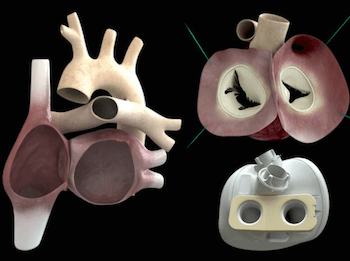Scientists say we blew it. We bought too many plastic trinkets; we drove too many petrol-guzzling trucks. We made babies like rabbits without questioning if the planet could handle so many people. Well, it looks like it couldn’t. Climate change is here to stay, and it will probably end up affecting nearly every aspect of our lives over the next century.
Like you, I’m not happy about this. But there are potential solutions. Not the ones politicians and environmentalists are pushing, like recycling, driving electric cars and lessening our carbon footprint. These are things I support, but I believe it’s too late to stop climate change. The way I see it, the race we’re in now — the challenge of the century for our species — is how quickly humans can adapt beyond our biological selves versus how quickly we destroy the planet.
Our species’ fate could hang on our transhuman evolution into a cyborg or machine-like state that’s far less vulnerable to environmental conditions.
There are four critical technologies humans will need to survive most environmental catastrophes — be it the changing climate, a large asteroid hitting the planet, or nuclear war (in case you forgot, the world still has about 25,000 nuclear weapons).
Immunotherapy
The first is new treatments for cancer caused by ozone layer depletion, increased petrochemicals in food production, or radiation fallout from disasters like Japan’s Fukushima meltdown.
Oncology has always hoped for a one-time cure for cancer, but the disease is so complex and varied that there may be no single magic bullet to be found. However, the field of immune-oncology — using the body’s own defence system to attack cancerous cells — is emerging as a promising new way to successfully treat the disease. It could end up rendering cancer far less deadly.
“Within 10 years almost everyone suffering from cancer will be treated with an immunotherapy, Dr Hoos, Vice President of Oncology Research at GlaxoSmithKline recently told Australia’s Herald Sun. One of the reasons many doctors are jumping on the immunotherapy bandwagon is that it may eliminate the need for toxic chemotherapy as a treatment. Instead, immunotherapy combines a number of other treatments based on the body’s natural defence system to make cancer less disruptive to patients’ lives.
Bionic Organs
Many people die because of organ failure, which is caused by many things, including cellular death, disease, and trauma. One major key to overcoming environmental threats to our biological bodies is better, more durable organs, including robotic ones. A revolution in this field is also underway.

French biotech company Carmat is already installing artificial hearts (pictured left) in patients that can last five years. There’s a chance these bionic hearts will one day be the equivalent of human hearts in how effective they are at moving blood (which carries all-important oxygen) around the body.
Meanwhile, we are making progress 3D printing organs, such as livers. While we have yet to produce a fully functioning organ, researchers have delivered created liver tissue samples outside the lab. These pieces of organ tissue provide way for researchers to test radical new drugs on organ cells without endangering a live patient. Scientists have already recreated skull bones, noses, and arteries, and other human body parts using 3D printed biomaterials.
But perhaps the greatest need in any environmental catastrophe is clean air to breath. The fact we need oxygen at every moment of our lives to operate normally is human beings’ major biological weakness — perhaps even more than eating. Artificial or bionic lungs could be an alternative.
Many hospitals have ventilator systems that assist nonfunctioning lungs and allow patients to survive when they can’t breathe properly, but so far they are complicated and bulky machines. Humans need such respiratory systems built inside themselves. BioLung is an option, an artificial device the size of a soda can that tries to replicate a lung. Human trials will start within two years.
According to WebMD, “University of Texas researcher Joseph Zwischenberger, MD, tried out the BioLung on sheep whose lungs had been badly burned by inhaling smoke. Six of the eight sheep on the BioLung survived five days, doing far better than ventilation machines.”
Another option is “oxygen shots,” a new technology already on its way. The technique involves injecting oxygen-filled microparticles into the bloodstream. Imagine it as something you might take a few times a day when breathing is difficult or impossible.
Wearable Tech for Temperature Control
Of course, it’s not just about staying alive. We want to thrive, not just survive. Which leads me to a third technology we absolutely would need: sophisticated wearable tech that keeps people cool or warm in the harshest conditions, whether it’s global warming or an ice age.
Our skin and temperature regulation can handle extreme temperatures for short periods of time, but long term, we need a stable, suitable climate. Some developing wearable tech is going this direction, offering cooling or heating built into the material.

Fuel Wear Flame Base, a crowdfunded smart-heated base layer, is meant to protect against extreme cold. It electronically warms up your clothes to keep you at just the right temperature, which could be really useful if the planet goes into a mini-ice age. Other clothing like those from ClimaWear (pictured left) claims to keep you cool when it’s super hot — just what we need when the polar ice caps melt and the world warms 20 extra degrees.
Indeed, ideally, the more cyborg parts we get, the less that heating or cooling will be an issue. Some biohackers hope to electively replace limbs with bionic ones within 10 years. These robotic limbs can already tie into our neural system and react to our thoughts, and they won’t need heating or cooling, lessening the overall burden on the body.
Food Alternatives
To speculate even further, a more mechanised body like that of a robot would not need food or water, that other great example of humanity’s fragility. But what if we could eliminate eating and drinking altogether?
Frankly, I think doing away permanently with caloric intake should probably be a goal of all humanity, since it presents massive hassle from an evolutionary point of view. Millions of people die worldwide every year from food poisoning, digestive issues, and especially malnutrition. The fewer organs we need (including our bowels) the better off we’ll be, and not needing food or water would dramatically lesson our reliance on the environment. If we were mostly integrated with machines, we could instead use other energy sources to power our bodies, like solar or fusion.
But let’s come back down to Earth for now. If we can’t (or don’t want to) eliminate our dependence on food, then it would be wise to find an abundant alternative calorie source that is healthy and nutritious. Something like Soylent, which is healthier than many corn-based products, and in the long run will not require as much food production to feed the world, especially livestock production.
Another food substitution might be synthetic food — edible, energy-providing substances created in a laboratory. The most promising is synthetic meat grown from stem cells. Meat is important since many people around the world eat it, and it’s dense in nutrition and calories. Creating cheap synthetic meat could mean much less reliance on Earth’s resources, since currently 30 per cent of the Earth’s usable land is dedicated to livestock and animal grazing.
Even in the next 50 years, life could get wild and dystopic. But I believe that no matter how bad the planet gets, our species can still thrive, by becoming a species not so dependent on Mother Earth, but rather on the technology we can create. It’s very possible we’ll be able to successfully do that, so long as we’re realistic with ourselves.
The strange truth is that in the very near future we may not need clean water or stable weather to sustain advances in our species. We may not need oceans or forests to feed us, or an ozone layer to help us avoid cancer. We may not even need the sun to shine bright, if we can perfect other forms of power. Existential risk can be overcome by adapting beyond the fragility of human biology.
Zoltan Istvan is the author of The Transhumanist Wager, founder of the Transhumanist Party, and 2016 US presidential candidate.
